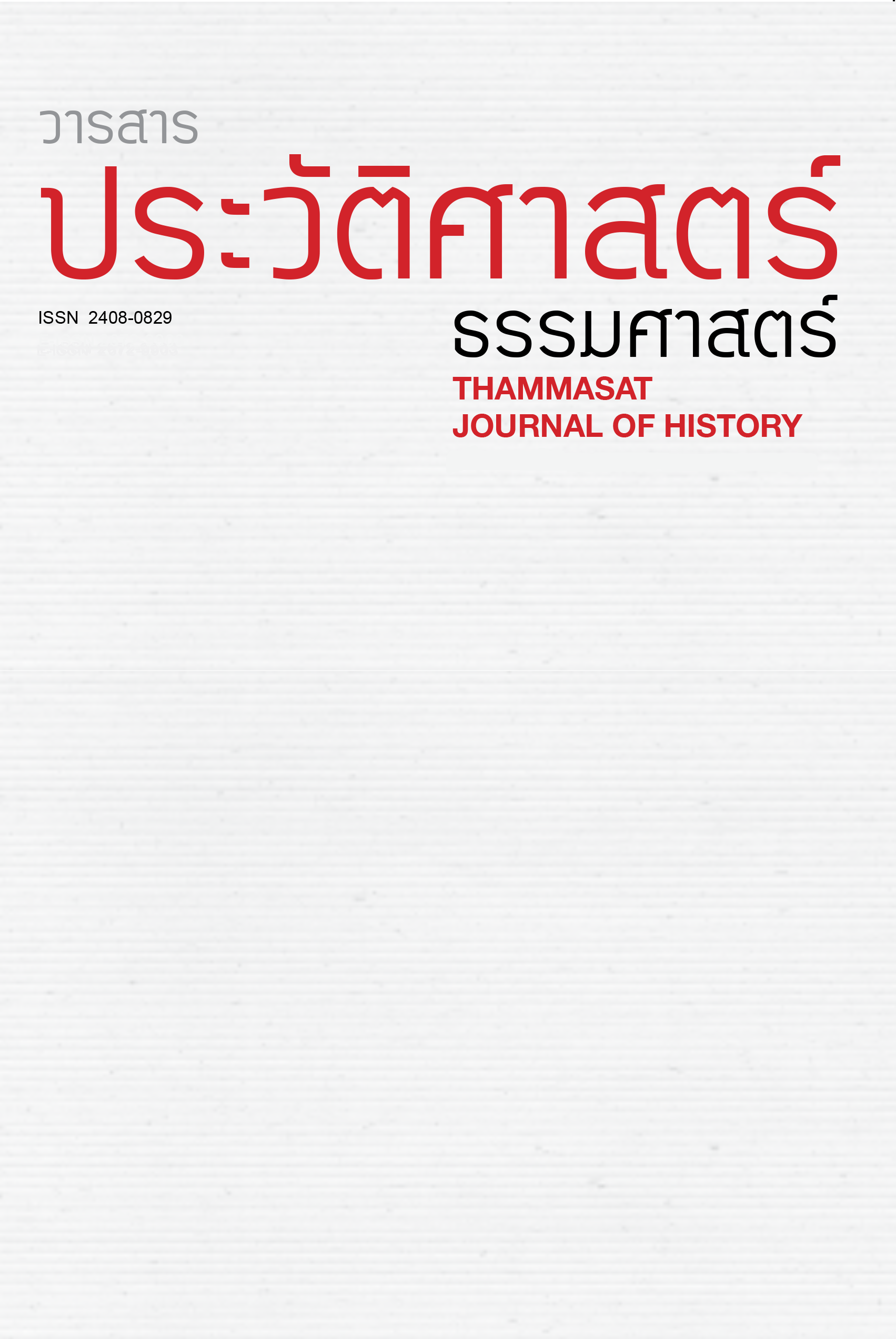The Revival and Reconstruction of Women Warriors’ Popular Representations in Thailand: Backgrounds, Motives, and Strategies of the Post-absolutist Regime
Main Article Content
บทคัดย่อ
Following 1932, Thailand has gone through a period of significant political and social transitions. Citizens became the focus of many social reforms introduced by the civilian government. The post-absolutist period witnessed a number of nationalist campaigns, which employed national martyrs as tools for promotion. From then on, the overlooked representations of women warriors were revived and reconstructed by the government. In this process, their myths were reintroduced, and their roles were reshaped to fit their new roles as state agents throughout the era, which included the era of anti-communist regime and the financial crisis of 1997. This paper aims to explore four Thai women warriors, Thao Suranari, Thao Thepkasatri, Thao Sisunthon, and Somdet-Phra Suriyothai in relation to the discourse of the state’s prescribed roles and popular representations. In order to understand the regime’s motives to revive and commemorate women warriors as national heroines, the paper is divided into three parts: (i) the state's prescribed role for women in official historiography; (ii) representations of the glorious female warriors as the nation’s role models; and (iii) official strategies and motives for the commemoration of female warriors. At the end, this paper will demonstrate the multiple functions of women warriors’ representations, who were modelled to serve various purposes for the government in different circumstances and crises that the nation had experienced.
Article Details
ลิขสิทธิ์บทความเป็นของผู้เขียนและสงวนสิทธิ์ตามกฎหมาย
ข้อคิดเห็นใดๆ ที่ปรากฏในวารสารนี้เป็นของผู้เขียน คณะกรรมการวารสาร ภาควิชาประวัติศาสตร์ฯ กองบรรณาธิการ ตลอดจนกรรมการกลั่นกรองประจำฉบับ ไม่จำเป็นต้องเห็นพ้องกับข้อคิดเห็นเหล่านั้น
เอกสารอ้างอิง
Andaya, Barbara Watson. The Flaming Womb: Repositioning Women in Early Modern Southeast Asia. Hawaii: University of Hawaii Press, 2006.
Barmé, Scot. Luang Wichit Wathakan and the Creation of a Thai Identity. Singapore: Institute of Southeast Asian Studies. 1993.
Barmé, Scot. Woman, Man, Bangkok: Love, Sex, and Popular Culture in Thailand. Oxford: Rowman & Littlefield. 2002.
Jones, David E. Women Warriors: A History. Washington: Brassey’s. 1997.
Kaewngamprasert, Saipin. Kan-maung Nai Anusawari thao Suranari Bangkok: Matichon Press. 1995.
Loos, Tamara. Subject Siam: Family, Law, and Colonial Modernity in Thailand. Bangkok: Silkworms Books. 2006.
Ratchaphantharak, Sunai. 200 Pi Wirasatri meuang Thalang. Phuket: Victory Powerpoint. 1985.
Reynolds, Craig J. Seditious Histories: Contesting Thai and Southeast Asian Pasts. Singapore: NUS Press. 2006.
Sinlapakon, Krom. Satri-Samkhan Nai Prawatisat Thai (Notable Women in Thai History). Bangkok: Krom Sinlapakon. 2004.
Satyanurak, Saichol. Somdet kromphraya damrong-rajanuphab: garn sang attalak meuangthai and chun khong chao sayam, Bangkok: Matichon Press. 2003.
Winichakul, Thongchai. Siam Mapped: A History of the Geo-body of a Nation. Hawaii: University of Hawaii Press. 1994.
Wongthet, Sujit. Phrasuriyothai Pen Krai? Ma Chak Nai? Bangkok: Matichon Press. 2001.
Jirattikorn, Amporn. "Suriyothai: hybridizing Thai national identity through film." Inter-Asia Cultural Studies 4, no. 2 (January 2003): 296-308. https://doi.org/10.1080/1464937032000113015
Kanchanaphan, Phirot. “Kan-totan Kan-khotsanachuanchuea Khong Fai-Khommunit doi Ratthaban-Thai: Sueksa chapo Korani Phak-thawanok-chiengnua.” Master’s thesis, Thammasat University. 1975.
Dunyakan, Sombun. “Kan-lukhue Khong Prachachon Nai Kan-totan Karn-khrobngam Thang-kanmeuang Khong Thahan: Korani Hetkan Duean Prutsaphakhom 2535.” Master’s thesis, Chiangmai University. 1996.
Gotoknow. “Album File”. http://www.gotoknow.org/file/konphet/poster4.jpg (Accessed October 8, 2011).
Nakhonratchasima Ratchaphat University, “Ya Mo Games”. http://www.nrru.ac.th/yamogame/main.php?pack=information&page=about4 (Accessed October 8, 2011).
“Hilight in Phuket”. Phuket Today. 2011. http://www.phukettoday.com/hilight_eng.php?id=264 (Accessed October 7, 2011).
Rakthinkamnert, Rawiwan. “Samruat baprian prawattisat-thai mua ‘chat’ pen khrueangmue thang kanmueang”. TCIJ. (December 2, 2014). https://www.tcijthai.com/news/2014/02/scoop/5154 (Accessed December 19. 2019).
Royjaithai. “Somdet Phra-Sisuriyothai”. http://www.royjaithai.com/phrasrisuriyotai.php (Accessed October 7, 2011).
Samnak-ngan Changwat Nakhonratchasima. “Prawat: History”. http://www.nakhonratchasima.go.th/nakhonrat/index.php?link=history&na=c4ca4238a0b923820dcc509a6f75849b (Accessed October 7, 2011).
Samplepete, “Rian thao Thepkasatri thao Sisunthon”. http://samplepete.com/product.detail_0_th_3608835 (Accessed October 8, 2011).
Siammongkol, “Rian Somdet-phra -Suriyothai”. http://www.siammongkol.com/productinfo.php?code=01366 (Accessed October 8, 2011).


